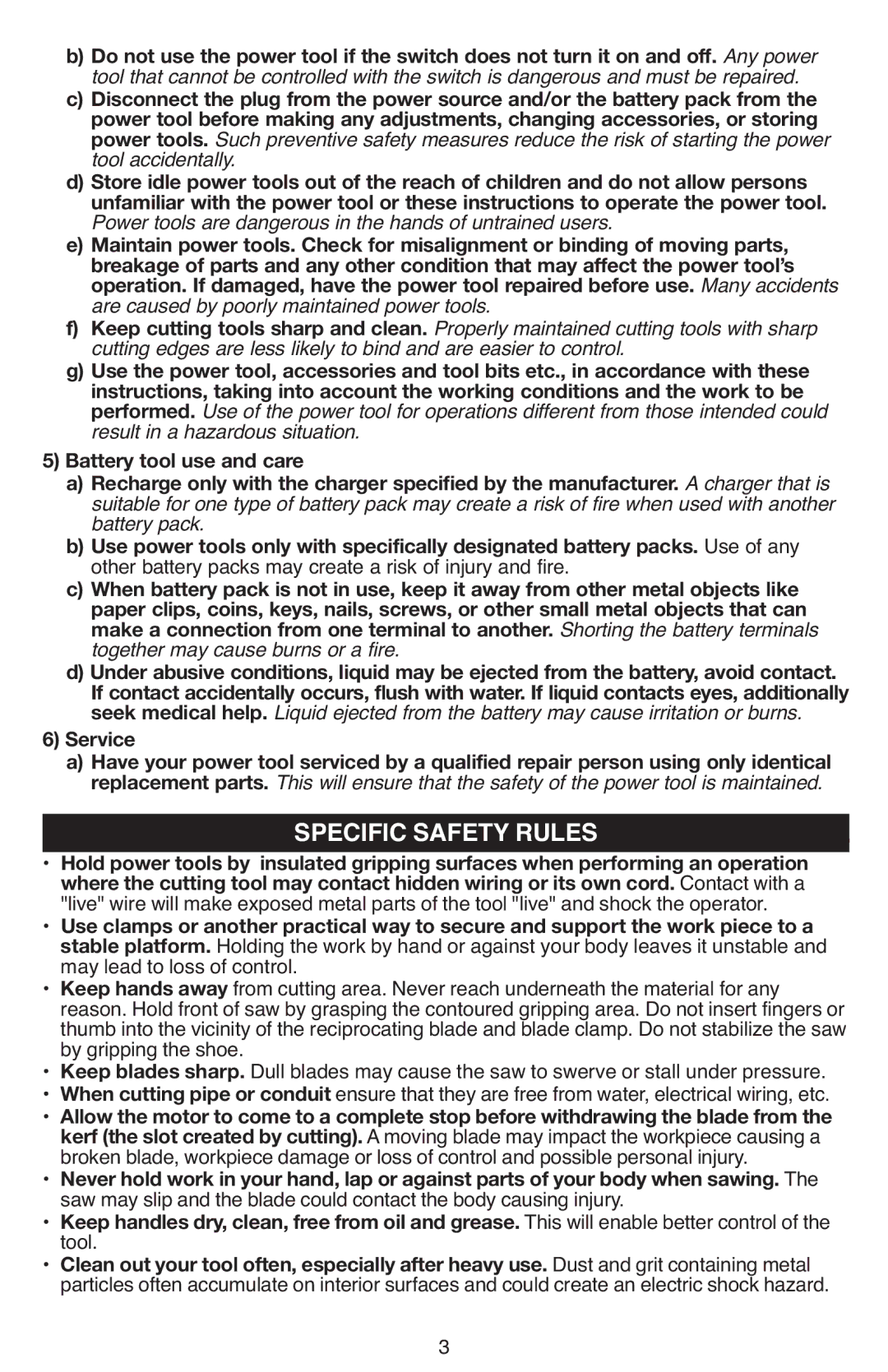Any power
b) toolD notthatusecannotthebepowercontrolledtool ifwiththetheswitchswitchdoesis dangerousnot turn itandon andmustoffbe. repaired.
c) Disconnect the plug from the power source and/or the battery pack from the power tool beforeSuch preventivemaki g anysafetyadjustments,measureschangingreduce theaccessories,risk of startingorthestoringpower toolpoweraccidentallytools. .
d) Store idle power tools out of the reach of children and do not allow persons
Powerunfamiliartoolswithare dangerousthe powerintooltheorhandsthe eofinstuntraineductionsusersto operate. the power tool.
e) Maintain power tools. Check for misalignment or binding of moving parts, breakage of parts and any other condition that may affect the powerManytool’saccidents areopercausedtion. Ifbydamaged,poorly maintainedhave thepowerpowertoolstool. repaired before use.
Properly maintained cutting tools with sharp
f) cuttingKeep cuttingedges aretoolslessharplikelyandto bindcleanand. are easier to control.
g) Use the power tool, accessories and tool bits etc., in accordance with these instructions,Usetakingof theintopoweraccounttool fortheoperationsworking conditionsdifferent fromandthoseth intendedwork to couldbe
resultperformedin a hazardous. situation.
5) Battery tool use and careA charger that is a) Rechargesuitable foroonely typewithofthebatterychargerpackspecifiedmay createby thea riskmanufacturerof fire when .used with another
battery pack.Use of any
b) Usotherpowbatterytoolspacksonlymaywithcreatespecificallya risk of injurydesignatedand firebattery. packs.
c) When battery pack is not in use, keep it away from other metal objects like
| paper clips, coins, keys, nails, screws, or other small metal objects that can | |
| make a connection from one terminal to another. Shorting the battery terminals | |
| together may cause burns or a fire. |
|
| d) Under abusive conditions, liquid may be ejected from the battery, avoid contact. | |
| seek medical help. Liquid ejected from the battery may cause irritation or burns. | |
| If contact accidentally occurs, flush wit | w er. If liquid contacts eyes, additionally |
6) Service |
| |
| replacement parts. This will ensure that the safety of thepower tool is maintained. | |
| a) Have your power tool erviced by a qualified repair p rson using only identical | |
• | SPECIFIC SAFETY RULES | |
wh re the cutting tool may contact hidden wiring or its own cord. Contact with a | ||
Hold power tools by insulated gripping surfaces when performing a operation | ||
• | "live" wire will make exposed metal parts of the tool "live" and shockthe operator. | |
st bl platform. Holding the work by hand or against your body leaves it unstable and | ||
Use clamps or another practical way to secure and s pp rt the work piece to a | ||
• | may lead to loss of control. |
|
Keep hands away from cutting area. Never reach underneath the materialfor any | ||
| reason. Hold front of saw by grasping the contoured gripping area. Do not insert fingers or | |
| thumb into the vicinity of the reciprocating blade and blade clamp. Donot stabilize thesaw | |
• | by gripping the shoe. |
|
Keep blades sharp. Dull blades may cause the saw to swerve or stall under pressure. | ||
• | When cutting pipe or conduit ensure that they are free from water, electrical wiring, etc. | |
• | kerf (the slot created by cutting). A moving blade may impact the workpiece causing a | |
Allow the motor to come to a complete stop before withdrawing the blade from the | ||
• | broken blade, workpiece damage or ossl of control and possible personal injury. | |
saw may slip and the blade could contact the body causing injury. | ||
Never hold work in your hand, lap or against parts of your body when sawing.The | ||
• | Keep handles dry, clean, free from oil and grease. This will enablebetter control ofthe | |
• | tool. | vy use. Dust and grit containing metal |
Clean out your tool often, especially after he | ||
| particles oftenaccumulate on interior surfaces and could create an electricshock hazard. | |
3
